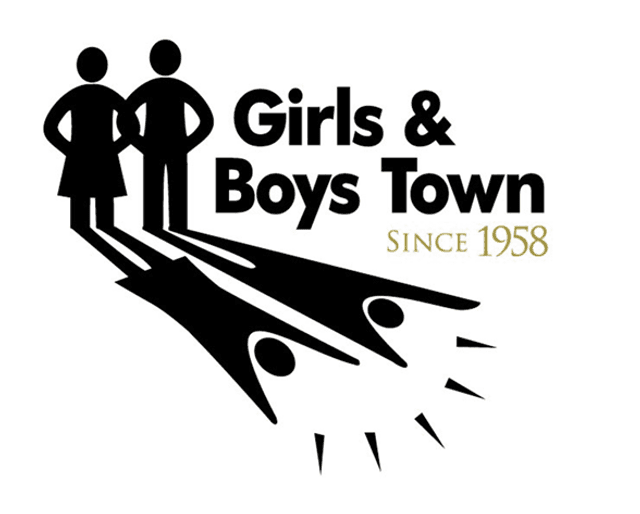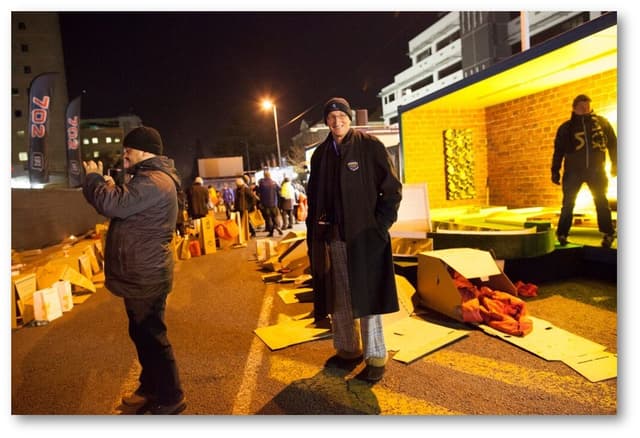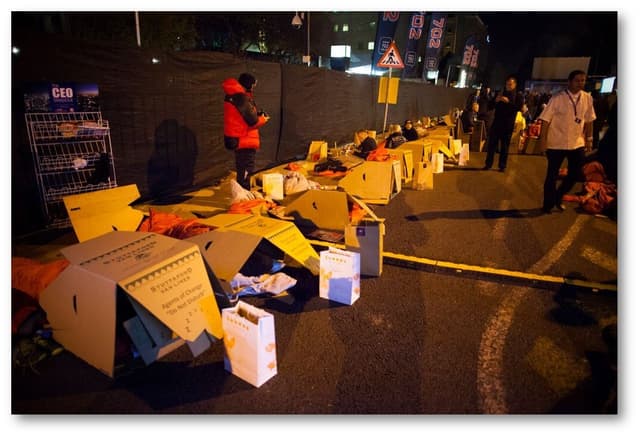CEO Sleepout: business leaders sleep rough for Girls and Boys Town
- Exhibited by
- Bessing Tsiga, donor development officer at Oasis Association
- Added
- June 16, 2016
- Medium of Communication
- Direct mail, online, broadcast
- Target Audience
- Individuals, Corporates
- Type of Charity
- Youth, homelessness, social justice
- Country of Origin
- South Africa
- Date of first appearance
- June, 2015
SOFII’s view
The CEO Sleepout started as a local community event in Sydney, Australia. It soon grew nationally and is now a global movement that enables business leaders to experience a small taste of homelessness and be part of international social change. Not everyone likes fundraising galas or sporting challenges but everyone sleeps!
Summary / objectives
The objective of the CEO Sleepout was to bring together CEOs from top performing companies in South Africa to:
1. Raise awareness in the country of the plight of homeless children and the issue of vulnerable children prone to homelessness in South Africa.
2. Raise money for an organisation called Girls and Boys Town, which works to ensure vulnerable children are kept off the street and empowered with life skills.
The CEO SleepOut™ initiative is part of a worldwide call to action to end homelessness by asking influential business leaders and decision-makers to sleep on the streets on one of the coldest and longest nights of the year.
Background
In 2006, Sydney business leader Bernard Fehon conjured up the idea for The CEO Sleepout while working on a fundraising dinner for the Australian nonprofit organisation St Vincent De Paul Society (Vinnies). Fehon knew that elaborate galas and dinners were, frankly, tired; not to mention often inappropriate when raising funds for those who could not afford a meal. He soon realised a CEO Sleepout would be easier than a CEO dinner and more innovative and effective in raising funds and awareness. After all, he said, not everyone can cycle or run for charity, but everyone can sleep. So, on one night, business and community leaders slept on the streets to reflect on their privilege. That first Vinnies CEO Sleepout raised AU$30 000. The Sydney Sleepout went national in Australia and is now in its eleventh year. In 2013, the event raised AU$5.3-million, and the 2015 Sleepout set its target at AU$10-million. Because homelessness is a global issue, the idea has spread worldwide – allowing business leaders the world over to experience a small taste of homelessness and aid in its eradication. It’s now a global call to action, leading to social change globally.
While on a philanthropic fact-finding mission in Australia, Ali Gregg, now founder and CEO of the CEO SleepOut™, heard about the Vinnies CEO Sleepout and was intrigued. Knowing South Africans were aspiring to a new approach to social innovation and a way to truly spark social entrepreneurship in the country, Gregg asked for – and received – Fehon’s ‘blessing’ to bring The Sleepout idea back home. On 18 June 2015, business leaders braced the winter’s cold to spend a night on the streets in South Africa.
Homelessness and drug abuse are rife in South Africa. Youth especially, due to high school drop outs, gang influences and unstable family structures are forced to stop school early and many end up on the streets. Girls and Boys Town is about giving these young people a second chance. The organisation provides homes to vulnerable youngsters, gives them a second chance through access to education and an empowerment programme helping to reduce the numbers of homeless youth.
The idea to have CEOs sleep outside was an intervention directly linked to the cause. ‘iA night of empathy’ as the CEOs would sleep outside in a wintry Johannesburg night to walk in the shoes of the neglected youth and homeless and in turn raise funds for Girls and Boys Town.
Creator / originator
Bernard Fehon, managing director of Tactical Solutions in Australia and Ali Gregg, founder of The Philanthropic Collection in South Africa
Special characteristics
What is special about this?
- Well, what isn’t entertaining and intriguing about putting the suits, heels and tie people in pyjamas? This was a fun idea that is different and caught the attention of a nation, directly bringing the attention to the issue of homelessness.
- The sleeping-out idea was a brilliant one as it was a direct link to homelessness. The event was done in the middle of winter and raised awareness and empathy for young people with no homes who are not choosing to be on the street.
- Thirdly selecting a great target market: CEOs! It could have been open to the public to participate, but it was genius to choose CEOs: influential people, who successfully drew attention to the plight of homeless young people.
- Corporate brands want to be associated with something good and the event gave the companies that, as the general public knew which companies are participating.
Influence / impact
The bonus of this event was the increased visibility of Girls and Boys Town and their work. The event also inspired others to give. Girls and Boys Town reported having a lot of people bringing in-kind donations: food, blankets and warm clothing for the homeless.
Some businesses organised Sympathy Sleepouts for employees to sleep outdoors at their own business premises. And schools took part with School Snoozeouts so school children could take part in their school grounds.
Costs
Corporate sponsorship helped with hosting the event – it’s the advantage of dealing directly with CEOs for your cause.
Results
You are probably wondering what exactly happened.
The first ever CEO SleepOut™ in South Africa happened in June 2015. Over 240 CEOs and executives from top-performing companies in the land joined in and slept on the street, raising a whopping R27million (£1.2m) for Girls and Boys town. What an achievement! And it is believed to be the largest amount raised in South Africa for a single event.
How did they get to R27 million? For one CEO to be able to get a bed on the street, he had to raise and pledge R100 000 (£4600) in support of Girls and Boys Town. With the participation of over 240 CEOs, they reached the R27million mark.
Huddled around braziers on the chilly June night, South African captains of Industry interacted with the homeless and listened to inspiring life-stories from GBT graduates. Participants received a sleeping bag and a cardboard chair which converted into a thin floor covering. Each realised it was more than many homeless people have and the mood was solemn as the reality of what it may be like to sleep on the streets every night crept in.
This case study was presented at IWITOT for the IFC 2016 by Blessing Tsiga, who was one of three audition winners for a speaker's place at IFC She was mentored by Bill Toliver, executive director of The Matale Line.
Also in Categories
-
- Events and Community






















